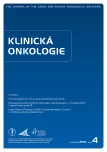Incidence and Risk Factors of Distant Metastases of Head and Neck Carcinoma
Authors:
Barbora Uhliarová; Martin Švec
Authors place of work:
Oddelenie otorinolaryngológie, FNsP F. D. Roosevelta, Banská Bystrica, Slovensko
Published in the journal:
Klin Onkol 2019; 32(4): 294-299
Category:
Původní práce
doi:
https://doi.org/10.14735/amko2019294
Summary
Background: Head and neck carcinomas are characterized by frequent metastases to cervical lymph nodes and locoregional recurrence. By contrast, distant metastases (M1) are seldom detected. Material and methods: This study retrospectively analyzed patients with head and neck cancer who were treated at the Department of Otorhinolaryngology of F. D. Roosevelt Faculty Hospital in Banska Bystrica in 2011–2017. M1 incidence, localization, and risk factors were determined, as well as time to development of M1, methods of M1 diagnosis, and patient survival. Results: M1 was diagnosed in 50 (10.5%) of 474 patients and was significantly more frequent in patients with oropharyngeal cancer, more extensive primary tumors (T3 and T4 status), nodal disease (N2 and N3 status), and poorly differentiated carcinomas. M1 was most often detected in the lungs (59%) and skeleton (47%). M1 was detected by computed tomography (CT) scans in 84% of patients and by, positron emission tomography/CT (PET/CT) in 12%. Mean patient survival was 10.4 ± 3.5 months, with two patients being in remission. Conclusion: M1 is detected most frequently by CT scans. PET/CT screening is indicated in patients with risk factors, including metastases to ≥3 lymph nodes or bilateral lymph nodes, lymph nodes >6 cm, low jugular lymph node metastases, or regional recurrence. Curative treatment is possible for patients with good performance status, solitary M1, and locoregional remission.
The authors declare they have no potential conflicts of interest concerning drugs, products, or services used in the study.
The Editorial Board declares that the manuscript met the ICMJE recommendation for biomedical papers.
Submitted: 22. 2. 2019
Accepted: 30. 5. 2019
Keywords:
diagnosis – head and neck carcinoma – distant metastasis – surviving
Zdroje
1. Gočárová K, Špánik S. Zriedkavé nádory hlavy a krku. Onkológia (Bratisl.) 2013; 8 (2): 78–82.
2. Wiegand S, Zimmermann A, Wilhelm T et al. Survival after distant metastasis in head and neck cancer. Anticancer Res 2015; 35 (10): 5499–5502.
3. Andrle J, Schartinger VH, Schwentner I et al. Initial staging squamous cell carcinoma: are they appropriate? J Laryngol Otol 2009; 123 (8): 885–888. doi: 10.1017/S0022215109005258.
4. Jäckel MC, Reischl A, Huppert P. Efficacy of radiologic screening for distant metastases and second primaries in newly diagnosed patients with head and neck cancer. Laryngoscope 2007; 117 (2): 242–247. doi: 10.1097/01.mlg.0000248232.27668.57.
5. Ferlito A, Buckley JG, Rinaldo A et al. Screening tests to evaluate distant metastases in head and neck cancer. ORL J Otorhinolaryngol Relat Spec 2001; 63 (4): 208–211. doi: 10.1159/000055741.
6. Senft A, Hoekstra OS, Witte BI et al. Screening for distant metastases in head and neck cancer patients using FDG-PET and chest CT: validation of an algorithm. Eur Arch Otorhinolaryngol 2016; 273 (9): 2643–2650. doi: 10.1007/s00405-015-3773-8.
7. Peters TT, Senft A, Hoekstra OS et al. Pretreatment screening on distant metastases and head and neck cancer patients: validation of risk factors and influence on survival. Oral Oncol 2015; 51 (3): 267–271. doi: 10.1016/j.oraloncology.2014.12.006.
8. Fakhry N, Michel J, Colavolpe C et al. Screening for distant metastases before salvage surgery in patients with recurrent head and neck squamous cell carcinoma: a retrospective case series comparing thoraco-abdominal CT, positron emission tomography and abdominal ultrasound. Clin Otolaryngol 2012; 37 (3): 197–206. doi: 10.1111/j.1749-4486.2012.02481.x.
9. Orlacchio A, Schillaci O, Antonelli L et al. Solitary pulmonary nodules: morphological and metabolic characterisation by FDG-PET-MDCT. Radiol Med 2007; 112 (2): 157–173. doi: 10.1007/s11547-007-0132-x.
10. Senft A, Yildirim G, Hoekstra OS et al. The adverse impact of surveillance intervals on the sensitivity of FDG-PET/CT for the detection of distant metastases in head and neck cancer patients. Eur Arch Otorhinolaryngol 2017; 274 (2): 1113–1120. doi: 10.1007/s00405-016-4353-2.
11. Abouzied MM, Fathala A, Alsugair A et al. Role of fluorodeoxyglucose-positron emission tomography/computed tomography in the evaluation of head and neck carcinoma. World J Nucl Med 2017; 16 (4): 257–265. doi: 10.4103/wjnm.WJNM_40_17.
12. Brouwer J, de Bree R, Hoekstra OS et al. Screening for distant metastases in patients with head and neck cancer: is chest CT sufficient? Laryngoscope 2005; 115 (10): 1813–1817. doi: 10.1097/01.mlg.0000174954. 51514.b7.
13. Uhliarová B, Švec M. Využitie PET/CT v otorinolaryngológii. Slov lek 2017; 9–10 : 18–24.
14. Calhoun KH, Fulmer P, Weiss R et al. Distant metastases from head and neck squamous cell carcinomas. Laryngoscope 1994; 104 (10): 1199–1205.
15. Chen F, Sonobe M, Sato K et al. Pulmonary resection for metastatic head and neck cancer. World J Surg 2008; 32 (8): 1657–1662. doi: 10.1007/s00268-008-96 31-8.
16. Winter H, Meimarakis G, Hoffmann G et al. Does surgical resection of pulmonary metastases of head and neck cancer improve survival? Ann Surg Oncol 2008; 15 (10): 2915–2926. doi: 10.1245/s10434-008-0001-4.
Štítky
Detská onkológia Chirurgia všeobecná OnkológiaČlánok vyšiel v časopise
Klinická onkologie

2019 Číslo 4
- Metamizol jako analgetikum první volby: kdy, pro koho, jak a proč?
- Nejasný stín na plicích – kazuistika
- Fixní kombinace paracetamol/kodein nabízí synergické analgetické účinky
- Kombinace paracetamolu s kodeinem snižuje pooperační bolest i potřebu záchranné medikace
- Antidepresivní efekt kombinovaného analgetika tramadolu s paracetamolem
Najčítanejšie v tomto čísle
- Vliv mikrobiomu na vznik a vývoj kolorektálního karcinomu
- Současný pohled na HPV asociované karcinomy orofaryngu a roli p16 jako surogátního markeru high-risk HPV
- Onkologická kazuistika – kdy je vhodný čas na integraci paliativní péče?
- Incidencia a rizikové faktory vzniku vzdialených metastáz u pacientov s karcinómom hlavy a krku
